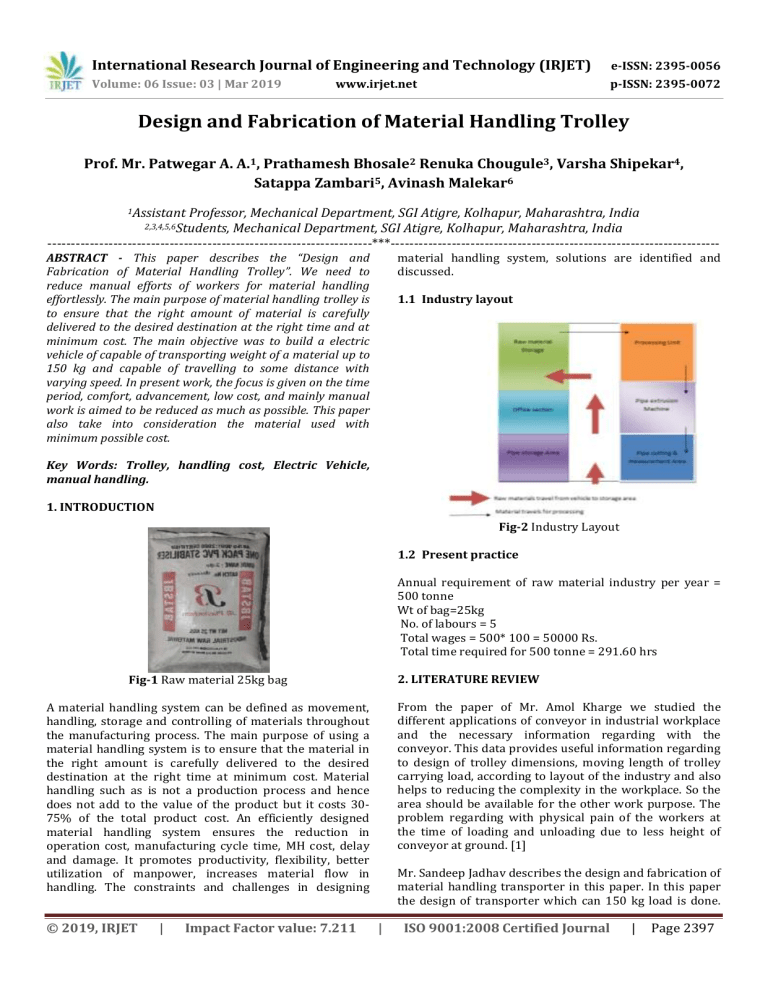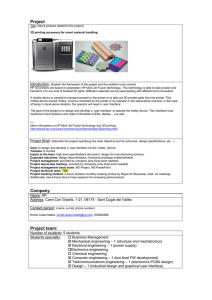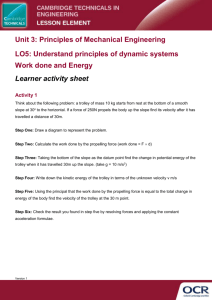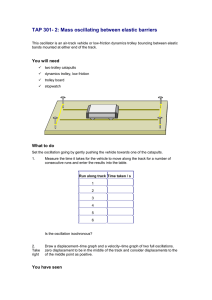IRJET- Design and Fabrication of Material Handling Trolley
advertisement

International Research Journal of Engineering and Technology (IRJET)
e-ISSN: 2395-0056
Volume: 06 Issue: 03 | Mar 2019
p-ISSN: 2395-0072
www.irjet.net
Design and Fabrication of Material Handling Trolley
Prof. Mr. Patwegar A. A.1, Prathamesh Bhosale2 Renuka Chougule3, Varsha Shipekar4,
Satappa Zambari5, Avinash Malekar6
1Assistant
Professor, Mechanical Department, SGI Atigre, Kolhapur, Maharashtra, India
Mechanical Department, SGI Atigre, Kolhapur, Maharashtra, India
---------------------------------------------------------------------***---------------------------------------------------------------------2,3,4,5,6Students,
ABSTRACT - This paper describes the “Design and
Fabrication of Material Handling Trolley”. We need to
reduce manual efforts of workers for material handling
effortlessly. The main purpose of material handling trolley is
to ensure that the right amount of material is carefully
delivered to the desired destination at the right time and at
minimum cost. The main objective was to build a electric
vehicle of capable of transporting weight of a material up to
150 kg and capable of travelling to some distance with
varying speed. In present work, the focus is given on the time
period, comfort, advancement, low cost, and mainly manual
work is aimed to be reduced as much as possible. This paper
also take into consideration the material used with
minimum possible cost.
material handling system, solutions are identified and
discussed.
1.1 Industry layout
Key Words: Trolley, handling cost, Electric Vehicle,
manual handling.
1. INTRODUCTION
Fig-2 Industry Layout
1.2 Present practice
Annual requirement of raw material industry per year =
500 tonne
Wt of bag=25kg
No. of labours = 5
Total wages = 500* 100 = 50000 Rs.
Total time required for 500 tonne = 291.60 hrs
2. LITERATURE REVIEW
Fig-1 Raw material 25kg bag
From the paper of Mr. Amol Kharge we studied the
different applications of conveyor in industrial workplace
and the necessary information regarding with the
conveyor. This data provides useful information regarding
to design of trolley dimensions, moving length of trolley
carrying load, according to layout of the industry and also
helps to reducing the complexity in the workplace. So the
area should be available for the other work purpose. The
problem regarding with physical pain of the workers at
the time of loading and unloading due to less height of
conveyor at ground. [1]
A material handling system can be defined as movement,
handling, storage and controlling of materials throughout
the manufacturing process. The main purpose of using a
material handling system is to ensure that the material in
the right amount is carefully delivered to the desired
destination at the right time at minimum cost. Material
handling such as is not a production process and hence
does not add to the value of the product but it costs 3075% of the total product cost. An efficiently designed
material handling system ensures the reduction in
operation cost, manufacturing cycle time, MH cost, delay
and damage. It promotes productivity, flexibility, better
utilization of manpower, increases material flow in
handling. The constraints and challenges in designing
© 2019, IRJET
|
Impact Factor value: 7.211
Mr. Sandeep Jadhav describes the design and fabrication of
material handling transporter in this paper. In this paper
the design of transporter which can 150 kg load is done.
|
ISO 9001:2008 Certified Journal
|
Page 2397
International Research Journal of Engineering and Technology (IRJET)
e-ISSN: 2395-0056
Volume: 06 Issue: 03 | Mar 2019
p-ISSN: 2395-0072
www.irjet.net
From this paper we get the information of torque
calculations, cost analysis etc. [2]
= 0.0509N
3. Calculating the acceleration force (FA):
FA= m * a
= 200*13.716/60^2
= 1.524N
Total tractive effort= RR+FA+Fd
= 1459.23+0.0509+1.524
= 1460.4N
Wheel motor torque = Tw= TTE*Rw*Rf
Rw= 0.1 m
Rf = Resistance factor= 1
Tw= 1460.4*0.1*1 = 146.04Nm
Now,
V= r*w
0.2286 = r* N*0.10472
0.2286= 0.1*N*0.10472
N = 21.82 rpm
• Power Calculations
P = (2*π*N*T)/60
= (2*π*21.82*146.04)/60
= 333.79W
Choosing 0.5 hp ( 373 w) electric motor.
Motor
Type – 3 Phase AC Motor
Output speed = 20 rpm
Ratio = 50
Reducer
Type- bevel gear
High Torque
High efficiency
Reversible
1000 : 1
After selection of electrical trolley for the purpose of
material handling the first step is to find out schematic
layout of the trolley in order to move forward in the
detailed design work of actual model. By using this paper
we are able to get the following points:
1. Needed area for the placing the electric equipments
such as electric motors.
2. Speed reducer required to reduce speed at time of
loading and unloading condition.
3. Mechanical components for engagement of different
components for transfer of torque from motor to wheel
such as chain drive. [3]
The next step of design of our electric trolley is the
designing each part of trolley separately. The selection of
proper dimensions in order to keep design in safe criteria.
we prefer the design data book, various catalogues and
tables provided taken in to consideration of trolley
dimensions, calculations and selection of motor for
particular purpose. [4]
Khurami Gupta and Bhandari these reference books are
also helpful for us while designing the various parameters
of trolley. Design of trolley parts on which basis selection
required?, which parameter should consider ?, what
should be assumptions? These all questions are get
clarified from these books. [5]
3. PARTS AND FABRICATION OF MATERIAL HANDLING
TROLLEY
3.1 Power calculation & selection of electric motor
• Data : Distance= 45 feet= 13.716m
Expected time= 60sec
Velocity= 13.716/60=0.2286m/s
Bag’s weight= 25kg
Quantity of bags=5
Weight of trolley=50kg
GVW = 5 * 25 + 50 = 175kg = 1716.75 N
Fig-3. 0.5HP AC motor used in trolley
• Total tractive effort requirement for trolley
Total tractive effort = RR+FA+Fd
Where, RR= Force required to overcome rolling resistance
FA= Force required to accelerate to final velocity
Fd= Force required to drag
1 .Calculating rolling resistance (RR):
RR=GVW*Crr
Crr = coefficient of friction between rubber and concrete=
0.6 – 0.85
RR= 31716.75* 0.85 = 1459.23 N
. Calculating the drag force (FD):
A= 0.8*1= 0.8m^2
Fd= 1/2*(Cd*1.1613 *A*V^2)
=1/2*2.1*1.1613*0.8*0.2286^2
© 2019, IRJET
|
Impact Factor value: 7.211
3.2 Base frame
Fig-4 Frame
|
ISO 9001:2008 Certified Journal
|
Page 2398
International Research Journal of Engineering and Technology (IRJET)
e-ISSN: 2395-0056
Volume: 06 Issue: 03 | Mar 2019
p-ISSN: 2395-0072
www.irjet.net
Base frame is the main buildings block. It carries all the
weight of the crane hand and load which is lifted by the
device. The frame is like the Truss structure.
3.3 Chain drive unit
N1 = 20 rpm
N2 = 22 rpm
Speed ratio (i) = 0.90
Z1 = 25
Z2 = 25*i=25*0.90=22.5
22 Selected
a = 36 cm=360mm
a = (30 to 50) P
P = 360/30
& P = 360/50
P = 12mm
& P = 7.2mm
Select max. Pitch (P)= 12 mm
Calculate no of chains in terms of no of links
lp=2ap+[(Z1+Z2)]/2+[(Z2 -Z1)^2/2*3.14]/ap
= 2*30+(25+22)/2+ [(25-22)^2/2*3.14]/30
= 83.50
Actual length of chain= 83.50*12
= 1002mm
Exact center distance
a =[e+√(e^2- 8m)]/4*p
e= lp-(Z1+Z2/2)=84- (20 + 22)/2=63
m= [(Z2-Z1)/2*3.14]^2
= [(22-20)/2*3.14]^2
= 0.1013
a = {[63+√(63^2-880.1013)]/4}*15.875
= 377.98mm
PCD Of Sprocket
Diameter of large sprocket
d1 = p/Sin (180/25)
= 12/Sin (180/25)
= 95.74mm
Diameter of large sprocket
d2 = p /Sin(180/22)
= 12/ Sin(180/22)
= 84.32mm
Length of chain = 100.5 cm
Center distance = 36 cm
Inclination = 45 degree
Fig-6 Actual Views of trolley operated by electric motor
4. RESULTS
Calculations For 1000 kg
Present Practice
No. of labour = 5
Labour for loading purpose
Labour for transportation purpose
Wage / Labour = 100Rs ………. For 1 tonne
No. of bags = 1000/ 25= 40bags ………… weight of
one bag is 25kg
• Total time required for 1 tonne = 35 to 40 min
• Total wages of labour = 500 Rs
• Electric motor operated trolley
• Transportation time of trolley = 2 min
• Loading and unloading time = 3 min
• Capacity = 10 bags
• No. of trolley travel trip = 4
Total time required = 20 min
Energy calculation of motor
•
0.5 hp motor is used
•
1 hp = 746 watt
•
0.5 hp = 373 watt
•
Time = 30 / 60 = 0.5 hrs
•
O.5* 373 = 186.5 W. hrs = 0.186 k W. hr = 0.186
unit
•
For 3 phase = 3*0.186 =0.558unit
•
Assuming cost for 1 Unit = 7 Rs.
Then, total cost = 3.906 Rs.
Calculation for 500 tonne
•
Present practice
•
Annual requirement of industry per year = 500
tonne
•
No. of labours = 5
•
Total wages = 500* 100 = 50000 Rs.
•
Total time required for 500 tonne = 291.60 hrs
•
By electric motor operated trolley
•
Total time required = 500* 30 min = 15000min =
250 hrs
•
Total unit required = (250* 373) / 1000 = 93.26
kw.hr
Cost = 652.75 Rs.
•
•
•
•
•
•
3.4 Assembling
Finally the whole body structure which consist of base
frame, , AC motor, chain drive unit, wheels , net are
assembled together.
Fig-5. Assembly of trolley
© 2019, IRJET
|
Impact Factor value: 7.211
|
ISO 9001:2008 Certified Journal
|
Page 2399
International Research Journal of Engineering and Technology (IRJET)
e-ISSN: 2395-0056
Volume: 06 Issue: 03 | Mar 2019
p-ISSN: 2395-0072
www.irjet.net
Mr.Prathamesh P. Bhosale
Student, Mechanical Engineering
SGI,Kolhapur,Maharashtra, India
Ms.Renuka S. Chougule
Student, Mechanical Engineering
SGI, Kolhapur, Maharashtra, India
Chart -1: Cost Vs Method
Ms.Varsha T.Shipekar
Student, Mechanical Engineering
SGI, Kolhapur, Maharashtra, India
Mr. Satappa I. Zambari
Student, Mechanical Engineering
SGI, Kolhapur, Maharashtra, India
Chart -2: Time Vs Method
Mr.Avinash P. Malekar
Student, Mechanical Engineering
SGI,Kolhapur,Maharashtra, India
5. CONCLUSION
The aim of our project is to reduce the cost of manual
material handling by use of trolley which is power by
electrical motor and capable of handling 150-175kg
weight.
6. REFERENCES
[1] Mr Amol B. Kharage, Prof. Balaji Nelge, “Analysis
and optimization of gravity roller conveyor
using ansys”, April 2015
[2] Sandeep Jadhav, Abhijit Dhangar, Vinayak Patil,
Shubham Pawar, Akash Waware, “Design and
Fabrication of Material Handling
Transporter”,june 2018.
[3] Ansh Mahil, Dheerendra Singh Rajput. “ Design of
Automatic Trolley”,Feb 2015
[4] “Design data book and catalogue.” By psg college
of technology
BIOGRAPHIES
Mr. Altaf A. Patwegar
Ass Prof. Mechanical Engineering
SGI, Kolhapur, Maharashtra, India
© 2019, IRJET
|
Impact Factor value: 7.211
|
ISO 9001:2008 Certified Journal
|
Page 2400



